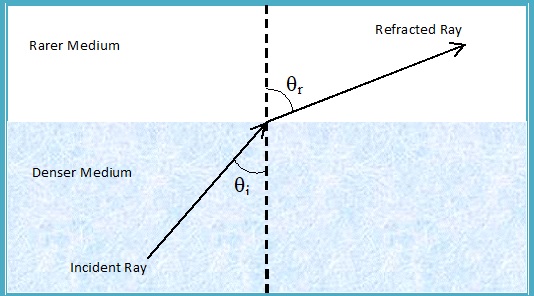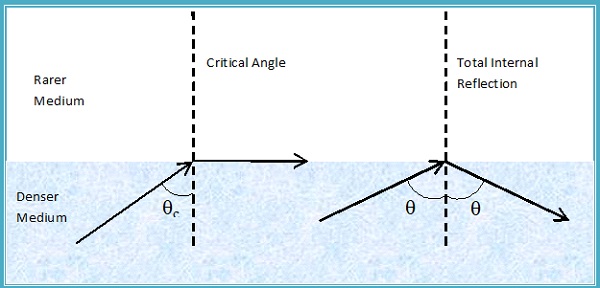
 Data Structure
Data Structure Networking
Networking RDBMS
RDBMS Operating System
Operating System Java
Java MS Excel
MS Excel iOS
iOS HTML
HTML CSS
CSS Android
Android Python
Python C Programming
C Programming C++
C++ C#
C# MongoDB
MongoDB MySQL
MySQL Javascript
Javascript PHP
PHP
- Selected Reading
- UPSC IAS Exams Notes
- Developer's Best Practices
- Questions and Answers
- Effective Resume Writing
- HR Interview Questions
- Computer Glossary
- Who is Who
Transmission of Light Through Fiber
In fiber optic communication, signals are transmitted through an optical fiber. This is based upon certain characteristics of light, namely refraction and total internal reflection.
Refraction
When a light ray goes from a denser transmission medium to a rarer one or vice versa, then its direction changes at the interface of the two medium. This phenomenon is called refraction of light.
The density of an optical medium is measured in refractive index. Higher the refractive index, denser it is.
The angle between the incident ray and the normal is called angle of incidence Θi, while the angle between the refracted ray and the normal is called the angle of refraction Θr. When light travels from denser to rarer medium, the angle of refraction is greater than the angle of incidence.

Critical Angle and Total Internal Reflection
For light propagating from denser medium to rarer medium, if the angle of refraction is ?90?^0, the corresponding angle of incidence is called critical angleΘc.
If a light ray is an incident at the interface of two media with an angle greater than the critical angle, it is completely reflected back to the denser medium. This phenomenon is called total internal reflection.

Transmission of Light in Fiber Optic Cable
Optical fibers use total internal reflection to transmit light. It has a solid core of dense glass surrounded by a less dense cladding. The light ray passing through the inner core is reflected back instead of being refracted to the rarer cladding.

Theoretically, there should not be any loss of light waves due to total internal reflection. However, attenuation of light occurs depending upon the wavelength of light waves and the properties of the glasses. The three commonly used wavelength bands for propagation are 0.85 microns, 1.30 microns, and 1.55 microns.
Propagation Modes
There are two modes of propagation of light −
Single Mode: It is a single strand of glass fiber that allows only one beam of the light signal to propagate. The core has a very small diameter of 9?m.
Multimode : It allows multiple beams from the light source to move along different paths. The core diameter is either 50μm or 62.5μm.

